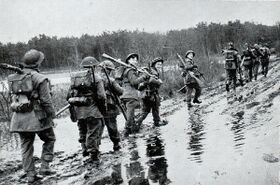Operation Sequoia
This article is incomplete because it is pending further input from participants, or it is a work-in-progress by one author. Please comment on this article's talk page to share your input, comments and questions. Note: To contribute to this article, you may need to seek help from the author(s) of this page. |
| Operation Sequoia | |||||||
|---|---|---|---|---|---|---|---|
| Part of the Asianna and the Pacific Campaign of the Second Europan War | |||||||
 Troops of the 11th Armoured Division march across the Cheorwon-Hwacheon Road in the midst of the Autumn Rains | |||||||
| |||||||
| Belligerents | |||||||
| Commanders and leaders | |||||||
| Strength | |||||||
|
65,000 troops 120 tanks 170 APCs 70 guns 75 aircraft |
80,000 troops 200 tanks 250 APCs 95 guns 100 aircraft | ||||||
| Casualties and losses | |||||||
|
| ||||||
Operation Sequoia (30 August - 15 October 1943) was an Allied strategic operation planned by General Okita Hanamura as a failsafe operation designed to mitigate the possible effects should the Concordian-Joyonghean attacks at Taeju, which started 7 days prior fail. The key executioner of the operation was Major-General Albert Crocker.
Prior to the operation, Crocker hoped to find a way to make the operation as a diversionary attack in order to make Marshal Hồ Danh Sĩ Quốc think that the Allies will attack in two flanks. In concept, the operation plotted by the Lucians were to reduce the number of troops that the Imperials could have at Taeju and Paju, that even if Stilwell failed at Taeju, the Allies would not suffer much area losses. As such, Crocker chose to attack the counties at Cheorwon and Hwacheon, which had already deemed unimportant by the Queminese High Command. 15 days after the operation began, Lucian forces successfully seized key villages around the Hwacheon County. When the time came to cross into the Cheorwon County, the autumn rains came which slowed his advance. When Marshal Ho heard of the seizing of the Hwacheon County, he separated Count Quách Khánh Thắng Due's forces from the main army to bottle up Crocker's thrust.
Crocker's forces subsequently encountered heavy engagements at the Cheorwon County. When the news that the Concordians and Joyongheans had failed at Taeju and Marshal Ho shifted his focus on ZANAC forces at the Yeoncheon County and its hill, Crocker shifted the battle plans of Sequoia from that of taking the county into a fight to race against time. Hanamura ordered Crocker to hasten his progress and to relieve the ZANACs at Yeoncheon. Meanwhile, Marshal Ho realised that Lucian forces were shifting its drive to relieve the Allies at Mushroom Hill. He ordered Count Due to prevent and slow the Lucian advance just enough for his forces to destroy the ZANACs besieged at Yeoncheon and on the Hill. Due decided to fight a war of attrition in order to bog down Crocker's forces, inflicting as much casualties as possible. Crocker countered this by yielding the entire Cheorwon county just enough for Due to stretch his lines as the continuous autumn rains meant supplies took long to arrive for the Quenminese. In 9 October, Crocker made his move and subsequently attacked Quenminese troops along the lines while ordering a part of his forces to race towards Yeoncheon. By the time Crocker got to the end of the county, Due was too late to prevent the Allied push and subsequently ordered his forces to withdraw further north to prevent mounting casualties.
By 15 October, Crocker's forces finally crossed into the Yeoncheon County to relieve both the town and the hill. Crocker's forces finally arrived in 18 October and relieved the Yeoncheon garrison, subsequently relieving the Hill just after 2 days.